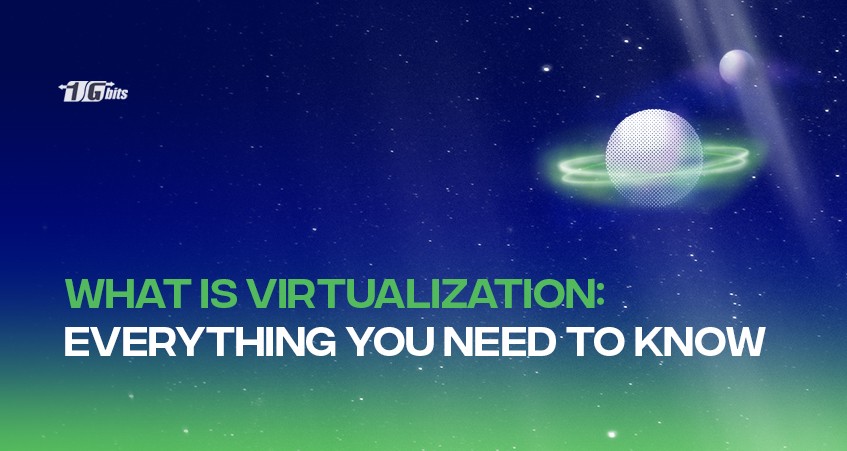Although virtualization technology dates back to the 1960s, it wasn't until the early 2000s that it became widely used.
Hypervisors, one of the technologies that made virtualization possible, were created decades ago to allow numerous users to access batch-processing computers concurrently.
Due to its broad use, virtualization became the cornerstone of cloud computing and helped lessen vendor lock-in.
Today, it is so commonplace in businesses that specialized virtualization management software is frequently required to keep track of everything.
What is virtualization?
Virtualization is known as running a virtual version of a computer system in a layer apart from the actual hardware.
It most frequently refers to using many operating systems simultaneously on a computer system.
The operating system, libraries, and many other programs that make up the guest virtualized system are distinct from the host operating system that runs below it, giving the impression to applications that operate on top of the virtualized machine that they are on their dedicated computer.
To meet their storage and processing demands, enterprises frequently find it ineffective and expensive to deploy several servers. Instead of using a single real hardware system, virtualization enables the creation of many simulated environments.
Hardware virtualization, frequently used interchangeably with the term "virtualization," is essential to effectively delivering IaaS (Infrastructure-as-a-Service) solutions for cloud computing.
In addition, virtualization technologies offer a virtual environment for networking, memory, storage, and application execution alongside application execution.
How does virtualization work?
A program, a guest OS, or data storage are all segregated from the underlying hardware or software through virtualization.
The functions and operations of the underlying hardware are replicated for the abstracted hardware or software by a thin software layer known as a hypervisor, producing numerous virtual machines on a single physical system.
The hypervisor handles all communications between hardware and virtual machines. While VMs use the same processing power, hypervisors distribute resources and make sure they get along.
The hypervisor's duties include managing and allocating computing resources and providing security.
By isolating VMs, the virtual environment's other computers are shielded from any faults or crashes on one virtual machine.
For most systems and applications, the performance of these virtual machines is still more than enough, even though it may not be on par with the OS running on real hardware.
This is because most applications and systems do not fully utilize or require the underlying hardware.
The virtual computers (again, created by virtualization) provide its customers additional isolation, flexibility, and control once this dependency is gone. Let's now take a quick look at the different types of virtualization.
Types of virtualization
Virtualization was initially primarily intended for server virtualization. However, the technique's acceptance has aided in its development and growth. We'll talk briefly about each kind.
Network virtualization
Today's communication networks are big, dynamic, and getting more complicated. Because of their heavy reliance on technology, the structure is inflexible and expensive to maintain.
Therefore, it becomes time-consuming to modify or introduce new goods and services.
This is the point at which virtualization is used. Network virtualization divides the available bandwidth into mobile, independent channels.
In other words, it is possible to change or instantly assign each channel to a certain server or device.
By dividing the network into digestible chunks, virtualization hides its true degree of complexity. This enables modifications and resources to be deployed on individual channels rather than the entire network.
Storage virtualization
In this procedure, many storage devices' physical space is pooled into a single unit.
A central console is then used to administer this solitary storage unit. Storage virtualization aids businesses in efficiently using storage by reducing high administrative expenses.
Virtual storage seems to users to be the same as a typical read or write to a real drive. It conceals the storage system's complexity, making it simpler and quicker for users and administrators to complete activities like backup, archiving, and recovery.
Desktop virtualization
In this method, a workstation rather than a server is virtualized. The use of a thin client enables remote desktop access for the user.
A thin client is an inexpensive endpoint computing system that heavily relies on a network connection to the main server for its computational functions.
Accessing the workstation is now simpler and more secure because it runs on a data server. It also helps by eliminating infrastructure and operating system license requirements.
Data virtualization
Applications can acquire and manipulate data using this data management method without requiring technical knowledge.
Data management and retrieval can be performed without being aware of the data's location, format, or source.
It facilitates greater access by offering a single and integrated view of corporate data in (almost) real-time as needed by apps, processes, analytics, and business users.
Application virtualization
At this point, the OS and application layers are abstracted. This makes it possible for the application to function in an enclosed manner without relying on the underlying OS.
A Windows application can run on Linux thanks to application virtualization.
Server virtualization
The resources on the server are concealed from server users throughout this operation.
This provides details about the number of servers, the users' names, the processors, and the operating systems used by each server.
The user is spared from comprehending and handling the server resources' complexity in this way. The procedure also improves resource utilization and sharing while preserving room for growth.
Benefits of virtualization
Virtualization has many advantages that practically any business or development environment may use.
Decreased costs
The cost of computing power is high. If investing in new hardware is the only method to increase resources, the cost quickly rises.
Using virtualization techniques to spot unused or underutilized computing resources, you can scrutinise your current infrastructure.
Too frequently, businesses set up servers to run programs that only use a small portion of their resources. Such servers are seldom utilized to their maximum capacity. Even worse, these servers are completely idle while their applications are not active.
You may provide each virtual machine (VM) with exactly the quantity of computing power it needs to carry out its function in a virtualized environment. Other VMs and their apps can then use the leftover resources.
Costs associated with virtualization are typically less than those associated with purchasing and maintaining extra hardware.
Resiliency
Unlike a traditional environment, a virtualized server environment is not constrained by hardware. VMs are simple to duplicate, clone, and back up to separate physical hardware.
New gear may take several days or even months to be ready for deployment. In the interim, you can quickly deploy a VM backup.
Improved effectiveness
Physical ecosystems are far more difficult to maintain than virtual ones. Virtualization allows you to configure, control, and update your VMs from a single machine rather than managing several physical servers requiring unique care.
This reduces the time it takes to deploy updates, apply security fixes, and install new software.
The IT crew worries less about managing physical machines because there is less hardware to manage.
Developers will also appreciate the effectiveness of quickly launching a VM without worrying about including new hardware.
Virtual environments are, by definition, scalable. To help handle a strong demand, you may quickly deploy many instances of the same VM, providing effective scalability that is constantly prepared to support and sustain growth.
Easy DevOps
You can divide a working environment into multiple virtual machines using virtualization. To test an app or complete another activity, any developer can rapidly swap from one VM to another.
It won't be necessary for developers to request a new PC with the necessary operating system.
Instead, they can finish their assignments. The independence of DevOps is a crucial component in the list of advantages of virtualization.
Easier disaster recovery
In a virtualized environment, the disaster recovery procedure is quite straightforward.
Your virtual machines may be quickly backed up and restored thanks to routine snapshots that provide the most recent data.
Virtual machines can be moved to a different site in minutes, even in a disaster.
Virtual firewalls and security
Although security is a major concern for businesses, virtualization nevertheless provides a solution, which is one of the crucial commercial advantages of virtualization.
Businesses can use virtual firewalls to secure data and access at a lower cost than traditional approaches. Having a qualified and seasoned security specialist manage your security activities is also advantageous.
Utilizing sophisticated controls, such as a virtual switch, to thwart malicious attacks from unidentified sources constitutes virtual security.
Virtual apps are isolated to protect them from various risks, such as viruses, malware, and other programs that can cease execution.
IT that is sustainable.
Long-term virtualization is an environmentally responsible method of handling IT. Reducing hardware requirements significantly lowers electricity usage, which minimizes our carbon impact in the end.
Both the environment as well as your bottom line will benefit from this. Power reductions make it less expensive to maintain servers and data centres.
All that money can then be used for other endeavours, such as increasing your company.
Disadvantages of virtualization
Running virtualized machines has drawbacks, just like everything else.
The major issue with virtualization is that everything hosted on a server will be impacted if the server experiences hardware issues or goes offline.
It's crucial to consider the resources each virtual environment needs while developing virtualizations.
On a host, there is a risk of system overload when multiple virtual machines are active. Performance may suffer if there aren't enough resources to handle multiple concurrent sessions.
Conclusion
Information technology has experienced a boom and expansion unlike any other over the past ten years. Many IT administrators must compromise between providing peak performance services and cutting expenditures.
It means they have to make the most of their limited resources. Virtualization is one approach that enables them to achieve this.
To imitate an environment, specialized software is used in virtualization. The program will imitate physical hardware in a virtual environment in bare metal virtualization. Even though it is merely software, it will function exactly as a real server would.
Although it might not be the best solution for every company, virtualization offers a starting point. It is a learning tool for those trying to improve their IT strategies and make the most of their present technology.
People also read:










